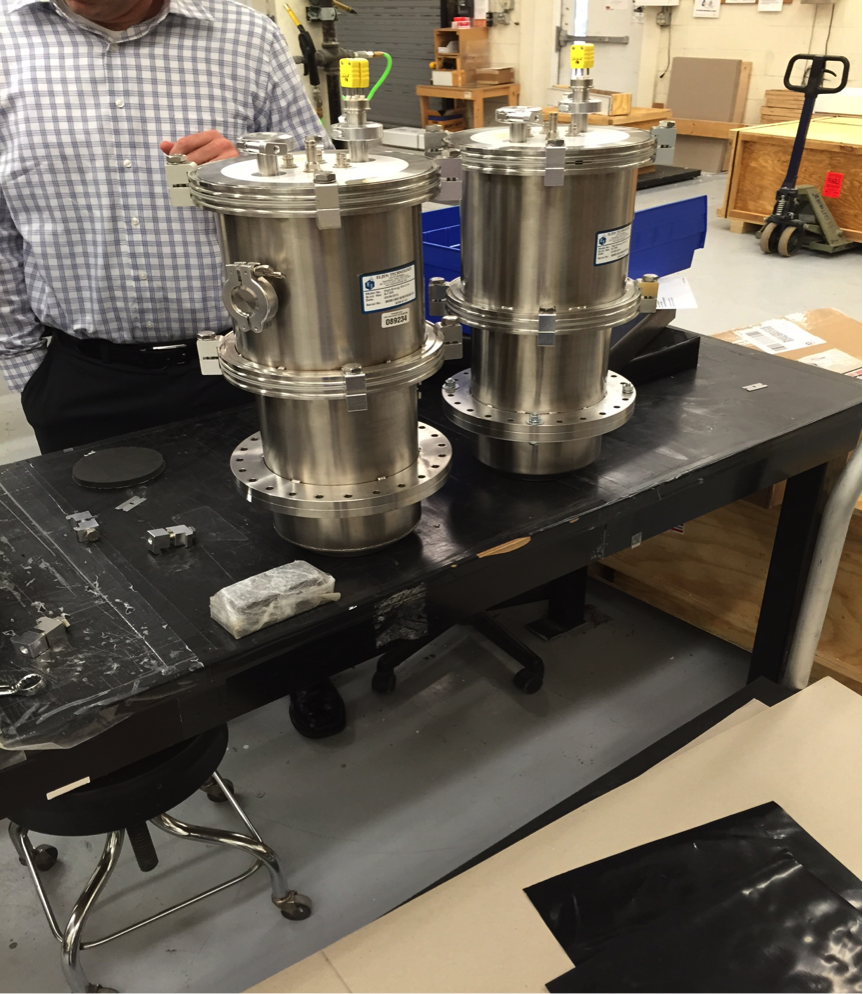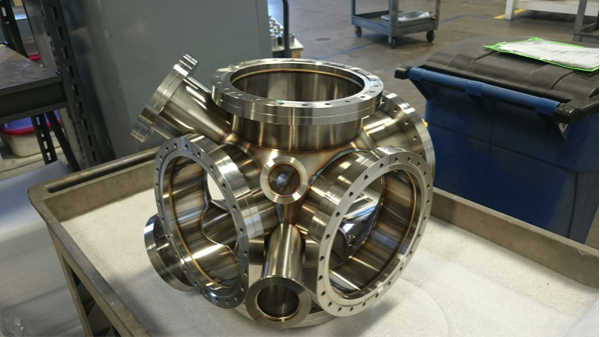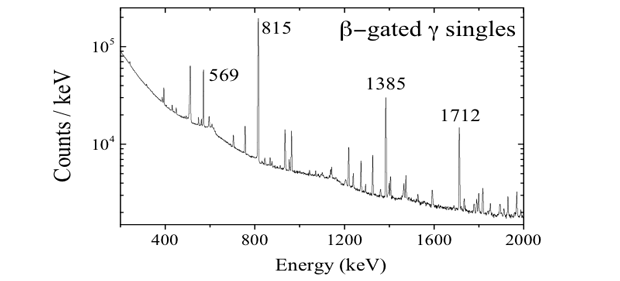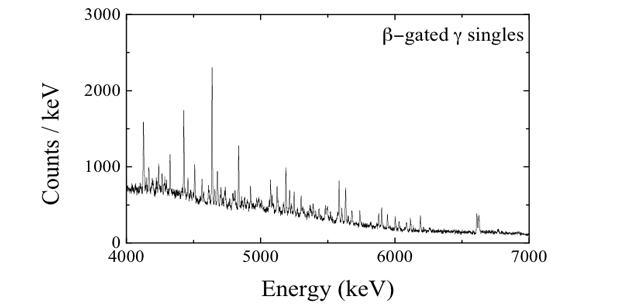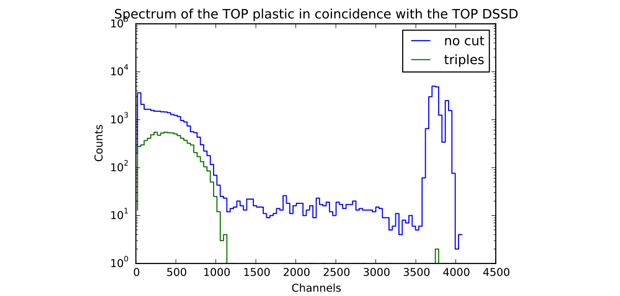Stephen Padgett (14-LW-087)
Abstract
Nuclear reactors are copious sources of antineutrinos. However, there is a discrepancy between the detected and predicted number of antineutrinos coming from reactors. This anomaly leads some scientists to suspect a fourth, sterile-type neutrino may exist. A set of measurements aimed at resolving this discrepancy was initiated with this project. We determined the energy spectra of the antineutrinos from the beta decay of the atomic nuclei whose decays contribute the most to the reactor antineutrino signal. Knowledge of these energy spectra is necessary to improve predictions of the amount of antineutrinos emitted. These predictions currently use assumptions that have yet to be confirmed with experimental data. Furthermore, those assumptions typically state that the isotopes of importance will decay through one type of beta-decay transition, known as an “allowed” transition, which is actually not likely for most of those isotopes. We developed plastic scintillator detectors to measure the shapes of the energy spectra of beta particles from the decay of the most important isotopes. A calibration measurement for these detectors was performed at Argonne National Laboratory in Argonne, Illinois, by studying the well-characterized lithium-8 beta decay in an ion trap. The same detectors in the same geometry are ready to be utilized for measuring the beta spectral shapes of rubidium-92 and yttrium-96, the two most important isotopes for the reactor antineutrino signal. Beta spectra measurements from lithium-8 decay are currently under analysis and gamma spectroscopy data on rubidium-92 are also collected and under analysis. Analysis of these measurements are needed to improve data for predictions of reactor antineutrinos.
Background and Research Objectives
Nuclear reactors provide the highest intensity sources of man-made antineutrinos, which are emitted in the beta decay of all the neutron-rich fission products. As a result, these antineutrinos are of great interest for fundamental neutrino physics, nonproliferation monitoring, and reactor physics. The need to precisely understand the antineutrino spectra emitted from the products of fissioning systems is underscored by (1) the first measurements of θ13 from the Daya Bay, RENO (Reactor Experiment for Neutrino Oscillations), and Double Chooz experiments;1–3 (2) the suggestion that there may be a reactor antineutrino anomaly caused by sterile neutrinos (the anomaly being that only about 94% of expected antineutrinos are actually measured);4 and (3) the potential use of antineutrino monitoring for nuclear safeguards.5
There are two motivations for this project. The first is fundamental neutrino science: an anomaly between the expected and measured number of antineutrinos from reactors suggests the existence of a fourth, sterile neutrino (one that does not participate in the weak interaction) that may or may not be hot, dark matter. Resolving the question of this anomaly’s existence is an appropriate first step in determining whether such a particle exists. Second, any improvements in understanding the quantity and nature of antineutrinos emitted from nuclear reactors will help in nonproliferation monitoring of those reactors.
There are many pieces of information needed to predict how many antineutrinos should be detected outside of reactors. Literature covers how all of these factors—such as finite charge distribution of the nucleus, screening from atomic electrons, and weak magnetism—are measured or calculated.4,6 The energy distribution of the antineutrinos is needed to determine how many will be detected. This can be directly determined if the full beta-particle energy spectrum is known. However, this is only possible when that beta spectrum is known for a particular isotope’s decay and also for the decay to a single state (e.g., ground state) in the daughter nuclide. Such information has not been measured to date for fission product isotopes relevant to the reactor anomaly. In its place, many scientists measure the beta spectrum from all fission product nuclei at once and construct models that approximate both the beta-energy spectra shapes for individual isotopes and the beta-decay branching distributions to the daughter isotopes. These models have one problematic assumption concerning the type of beta decays involved, in that their calculations assume allowed beta decays.6 However, many fission product nuclei contributing to this reactor antineutrino signal often decay through so-called first-forbidden beta decays. Such decays can easily have shapes that deviate from the allowed beta decay shapes.6,7 Even other literature sources calculate how first-forbidden beta decays may account for the anomaly entirely, and thus no discrepancy would exist.7 Such assumptions were tested in this project with a series of measurements on the beta decays of those isotopes most important for the reactor anomaly.
Scientific Approach and Accomplishments
With this project, we have begun work for the direct measurement of the beta spectra for individual isotopes, instead of modeling such decays to determine the antineutrino energy spectrum from fission product nuclei. By first measuring the beta energy spectra for the isotopes contributing the most to the detected antineutrino spectrum, one can construct the antineutrino energy spectra with no assumptions of shape, only measurements. According to literature, there are about 10 isotopes whose decays contribute to at least 30%, and possibly as much as 70%, of the overall antineutrino reactor signal.4,8 Those isotopes have larger decay-energy windows (Q values) and thus emit higher-energy antineutrinos on average, which are detected more readily in large detectors around reactors. The cross section for detecting these antineutrinos is roughly proportional to the square of their energies. Furthermore, those isotopes of importance are those that have large fission yields in reactors, emitting more antineutrinos than other fission product nuclei. Therefore, one can significantly cover the majority of the antineutrino spectrum by measuring the beta spectral of about ten isotopes as opposed to hundreds or thousands.
In this project, we performed two experiments. The first utilized the newly constructed scintillator detectors optimized for precision beta-decay spectroscopy. The experimental goal was to measure the shape deviation between an allowed beta-decay spectral shape and the true spectral shape for each fission product that was studied. To begin, the detectors had to be precisely calibrated at energies up to 10 MeV. These detectors were mounted into a chamber surrounding a beta-decay Paul Trap, a device that utilizes static and radiofrequency electric fields to trap ions of interest in the center and wait for decays to occur. The subsequent decay products, such as beta particles, are detected and energies are measured. The energies of the beta particles were measured coming from the beta decay of lithium-8. This particular isotope was used because it is an allowed-type beta decay. The beta spectral shape for an allowed decay was measured and later compared to the beta spectral shape for the fission product nuclide in question. Furthermore, because the beta decay in this ion trap occurs from rest, the decay kinematics can be utilized to reconstruct the energy of each beta particle. Thus, it is an over-constrained scenario. The energy spectrum shape is obtained from both the directly measured energies as well as event-by-event reconstruction from the measurement of energies and directions of the other decay products.
The design of the plastic scintillators was based upon detectors already in use for beta decay studies pioneered at LLNL. However, this only served as a starting point for the scintillator design used in this project (see Figure 1). The detectors’ volume was increased to accommodate the measurement of higher-energy beta electrons in the range of 10 to 20 MeV because the Q value of lithium-8 decay is 16 MeV. Higher-energy beta electrons need more detector volume to stop the particle and capture all of the energy. In addition, light-emitting diodes were placed inside the plastic to provide a constant light source for measuring any gain changes versus time.9 Such gain changes can alter the measurement, and a method is needed to track these changes to discern the true beta energy spectrum from internal detector fluctuations. Changes in the detector gain with temperature can also alter the measured energy spectral shape, leading to a misinterpretation of the data. Thermocouples were installed on both the side of the plastic scintillator as well as on the side of the photomultiplier tube to help discern the beta spectral shape and how it differs from the "allowed" shape. A shape factor quantifies how much, if at all, the beta spectrum of a fission product isotope differs from the assumed allowed shape.
A new chamber was constructed to hold these four plastic scintillators and was integrated into a tape station for the beta spectral-shape measurements on fission product nuclei (see Figure 2). This chamber was constructed to include four ports for these new plastic scintillators and two ports for two high-purity germanium detectors to measure gamma-ray energies as well, partly to assist in identifying isotopes present in the chamber. The chamber also includes two smaller ports for extra wiring for the possible inclusion of double-sided silicon detectors, in case it is determined that single-sided silicon detectors are insufficient.
Rubidium-92 Gamma Spectrum Measurement
The isotope rubidium-92 is ranked at the top of numerous lists of isotopes most important for the reactor antineutrino signal.6 We have established a collaboration with the physicists at Brookhaven National Laboratory in Upton, New York, to study this particular isotope and improve its decay data for reactor anomaly predictions. The ground-state-to-ground-state beta branching ratio in the literature is in question.10 Some sources claim it is approximately 51% decay and others place it around 95%. This discrepancy must be resolved because even this one property of one isotope leads to different results in calculations of expected antineutrinos from reactors.11
A gamma-ray spectroscopy measurement was performed at the CARIBU source at Argonne National Laboratory on the decay of rubidium-92. The X-Array, utilized for this experiment, contains five high-purity germanium clovers and a plastic scintillator for triggering the detector system on beta particles emitted in the decays.12 We are currently analyzing the data. The goal is to acquire sufficient gamma and beta counting data to determine the ground-state-to-ground-state branching ratio with a smaller error bar than in previous experiments. The current analysis is still on track to find many high-energy but weak gamma-ray transitions on the order of 0.005% of total decay intensity. This will be an increase in sensitivity on the ground-state-to-ground-state beta branching ratio measurement of about one order of magnitude over previous literature.13 The rubidium-92 decay gamma-ray spectrum is included in Figures 3 and 4.
Lithium-8 Calibration Measurement
We have completed measurements of the allowed beta decay of lithium-8 (Figure 5) using the plastic scintillators designed and constructed for this project. The measured shape of the beta spectrum will be determined through analyzing the energies deposited in the scintillators as well as gating upon the other decay products' final directions and energies deposited in thin silicon detectors to determine beta energy through decay kinematics. This data is currently being analyzed by a graduate student from the University of California at Irvine, who will include both this analysis as well as future rubidium-92 beta spectral shape measurements in a Ph.D. dissertation project. Once this data analysis is complete, the calibrated, allowed beta spectrum will be known. Comparisons can then occur after the beta spectra measurements for rubidium-92, yttrium-96, and other isotopes at the CARIBU source are complete.
Impact on Mission
This experimental work strengthens the Laboratory's core competency of nuclear, chemical, and isotopic science and technology, specifically on the nature of neutrinos and dark matter. The possible existence of sterile neutrinos and the reactor antineutrino anomaly are of great interest to the physics community—high-profile fundamental science research such as this helps attract top nuclear scientists to Livermore. A more reliable prediction of the antineutrino signal is also needed to support the work on nonproliferation monitoring, which supports the Laboratory’s mission in nuclear threat reduction.
Conclusion
Our project’s goal was to supply nuclear decay spectroscopy data needed for more accurate predictions of reactor antineutrinos. An anomaly may exist between how many antineutrinos are predicted to come from reactors and how many are actually measured. Such an anomaly suggests physics beyond the Standard Model, such as the existence of a fourth, sterile neutrino. Low-energy nuclear decay data is being provided from this project. The necessary gamma-ray spectroscopy data on the decay of rubidium-92 has been measured and is currently under analysis with the data group at Brookhaven National Laboratory. The long-term goal is to continue with these measurements while simultaneously seeking support to complete the list of the top ten isotopes. Each new beta spectrum will be measured and incorporated by neutrino physicists into their calculations for the reactor antineutrino anomaly. Ultimately we will be able to resolve the issue of whether the anomaly persists or not, and if so, by how much.
References
- An, F. P., et al.,”Independent measurement of the neutrino mixing angle θ13 via neutron capture on hydrogen at Daya Bay.” Phys. Rev. Lett. 108, 171803 (2012).
- Ahn, J. K., et al.,”Observation of reactor electron antineutrinos disappearance in the RENO experiment.” Phys. Rev. Lett. 108, 191802 (2012).
- Abe, Y., et al., ”Indication of reactor electron antineutrino disappearance in the Double Chooz experiment.” Phys. Rev. Lett. 108, 131801 (2012).
- Mention, G., et al., ”Reactor antineutrino anomaly.” Phys. Rev. D 83, 073006 (2011).
- Christensen, E., et al., ”Antineutrino monitoring for heavy water reactors.” Phys. Rev. Lett. 113, 042503 (2014).
- Huber, P., “Determination of antineutrino spectra from nuclear reactors.” Phys. Rev. C 84, 024617 (2011).
- Hayes, A. C., et al., ”Systematic uncertainties in the analysis of the reactor neutrino anomaly.” Phys. Rev. Lett. 112, 202501 (2014).
- Brookhaven National Laboratory Data Group, private communications.
- Saucke, K., et al., “Stabilizing scintillation detector systems with pulsed LEDs: A method to derive the LED temperature from pulse height spectra.” IEEE Trans. Nucl. Sci. 52(6), 3160 (2005).
- Tipnis, S. V., et al., “Yields of short-lived fission products produced following 235U(nth,f).” Phys. Rev. C 58(2), 905 (1998).
- Dwyer, D. A., and T. J. Langford, “Spectral structure of electron antineutrinos from nuclear reactors.” Phys. Rev. Lett. 114, 012502 (2015).
- Mitchell, A. J., et al., ”The X-Array and SATURN: A new decay-spectroscopy station for CARIBU.” Nucl. Instrum. Meth. Phys. Res. A 763, 232 (2014).
- Olson, R. J., W. L. Talbert, Jr., and J. R. McConnell, “Gamma-ray studies of the decays of 92Kr, 92Rb, and 92Sr.” Phys. Rev. C 5, 2095 (1972).


